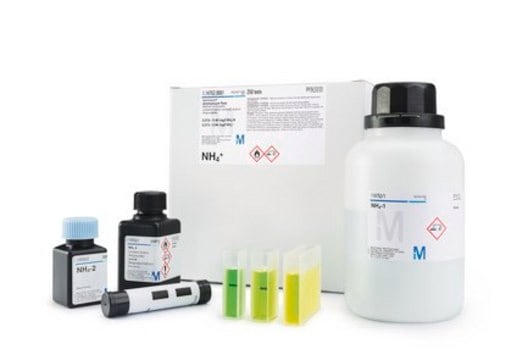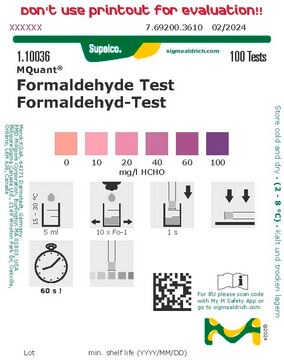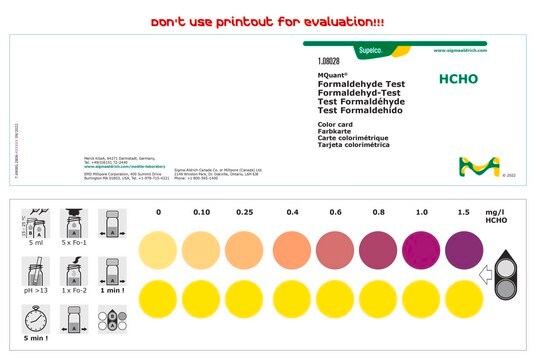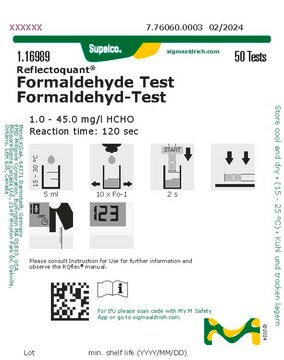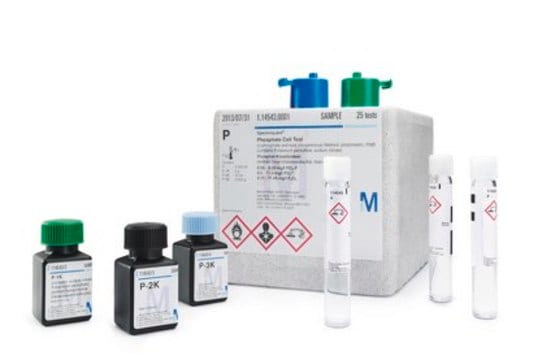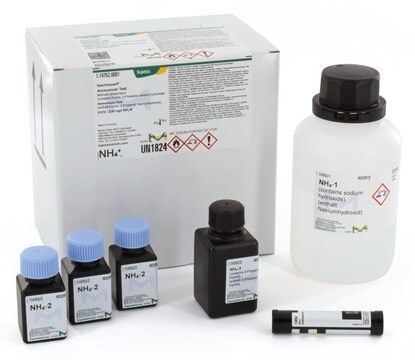1.14500
Formaldehyde Test, photometric
photometric, 0.10-8.00 mg/L (HCHO), Spectroquant®
About This Item
Empfohlene Produkte
Produktbezeichnung
Formaldehyd-Küvettentest, photometric, 0.10-8.00 mg/L (HCHO), Spectroquant®
Produktlinie
Spectroquant®
Qualitätsniveau
Verwendung
sufficient for 25 tests
spezifische(r) Analyt(en)
formaldehyde
Messbereich
0.10-8.00 mg/L (HCHO)
Methode(n)
photometry: suitable
Kompatibilität
for use with Spectroquant® Move 100
for use with Spectroquant® Nova 60 A
for use with Spectroquant® Prove 100
for use with Spectroquant® Prove 300
for use with Spectroquant® Prove 600
Nachweisverfahren
photometric
Lagertemp.
15-25°C
Allgemeine Beschreibung
This Spectroquant® Formaldehyde Cell Test allows the accurate quantification of the formaldehyde content in aqueous samples such as disinfectants, preservatives, or process wastewater.
Method applied: In sulfuric solution formaldehyde reacts with chromotropic acid to form a violet dye which is determined photometrically.
The Spectroquant® Cell Tests come with prefilled 16 mm round cells and all the required reagents to perform the analysis according to the instruction leaflet provided.
All Spectroquant® Cell and Reagent Test Kits are equipped with the unique Live ID (2D barcode) which allows seamless method recognition and contains essential information such as lot number, expiry date, and automatic calibration updates.
Anwendung
- Effect of formaldehyde exposure on phytochemical content and functional activity of Agaricus bisporus (Lge.) Sing: This research highlights the application of formaldehyde detection assays in studying the impact of environmental toxins on biological materials, which is critical for assessing chemical exposure and material safety in both laboratory and industrial settings (Kutluer, 2024).
- VOC data-driven evaluation of vehicle cabin odor: from ANN to CNN-BiLSTM: This study employs advanced formaldehyde detection techniques, integral for environmental toxin testing in automotive manufacturing, ensuring cabin air quality and safety standards are met (Tian et al., 2024).
- Graphene and metal-organic framework hybrids for high-performance sensors for lung cancer biomarker detection supported by machine learning augmentation: While primarily for biomarker detection, the sensitivity of these sensors could be adapted for high-sensitivity formaldehyde assays in biotech and pharma research, showcasing the inter-disciplinary application of formaldehyde assays (Tran et al., 2024).
- A metal-organic framework and quantum dot-based ratiometric fluorescent probe for the detection of formaldehyde in food: This study represents a direct application of formaldehyde cell tests in food safety, illustrating the role of formaldehyde detection assays in ensuring public health and compliance with safety regulations (Chen et al., 2024).
Rechtliche Hinweise
Sie haben nicht das passende Produkt gefunden?
Probieren Sie unser Produkt-Auswahlhilfe. aus.
Signalwort
Danger
H-Sätze
Gefahreneinstufungen
Eye Dam. 1 - Met. Corr. 1 - Skin Corr. 1A - STOT SE 3
Zielorgane
Respiratory system
Lagerklassenschlüssel
8A - Combustible, corrosive hazardous materials
WGK
WGK 3
Analysenzertifikate (COA)
Suchen Sie nach Analysenzertifikate (COA), indem Sie die Lot-/Chargennummer des Produkts eingeben. Lot- und Chargennummern sind auf dem Produktetikett hinter den Wörtern ‘Lot’ oder ‘Batch’ (Lot oder Charge) zu finden.
Besitzen Sie dieses Produkt bereits?
In der Dokumentenbibliothek finden Sie die Dokumentation zu den Produkten, die Sie kürzlich erworben haben.
Protokolle
Preparation of a standard solution for Formaldehyde
Unser Team von Wissenschaftlern verfügt über Erfahrung in allen Forschungsbereichen einschließlich Life Science, Materialwissenschaften, chemischer Synthese, Chromatographie, Analytik und vielen mehr..
Setzen Sie sich mit dem technischen Dienst in Verbindung.